Canon EF 70-200mm f/2.8L IS II USM
Canon EF 70-200mm f/2.8L IS II USM: Performance
Shooting wide open at 70mm yields images which have sharpness approaching excellent levels in the centre of the image area and approaching good towards the edges. Peak quality across the frame is achieved at f/11, where the quality towards the edges catches up with that of the centre.At 135mm and f/2.8 the sharpness in the centre is still very good and the quality towards the edges improves to very good levels. Peak quality across the frame is achieved at f/8, where sharpness is excellent across the frame.
By 200mm, this lens really comes into its own. Sharpness in the centre at f/2.8 is excellent, and the quality towards the edges is very good. Peak quality across the frame is achieved between f/5.6 and f/8, where the sharpness in the centre is outstanding and the quality towards the edges is excellent.
| Resolution at 70mm | Resolution at 135mm |
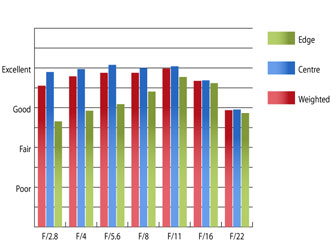 | 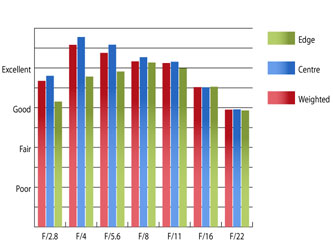 |
| Resolution at 200mm | How to read our graphsThe blue column represents readings from the centre of the picture frame at the various apertures and the green is from the edges. Averaging them out gives the red weighted column.The scale on the left side is an indication of actual image resolution. The taller the column, the better the lens performance. Simple. For this review, the lens was tested on an Canon EOS 5D MkII using Imatest. |
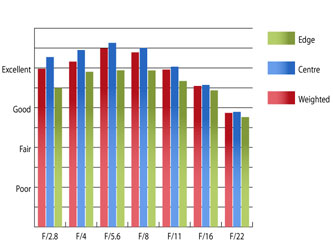 |
Chromatic aberrations are very well controlled throughout the range. The worst Imatest was able to detect fringing covering 0.61 pixel widths, which should barely be visible, even in very large prints on in harsh crops from near the edge of the image area.
| Chromatic Aberrations at 70mm | Chromatic Aberrations at 135mm |
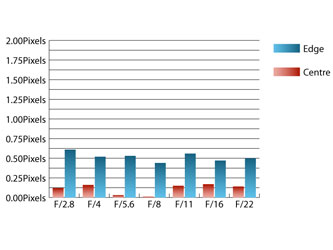 | 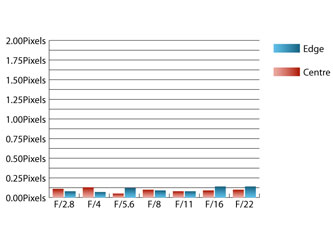 |
| Chromatic Aberrations at 200mm | How to read our chartsChromatic aberration is the lens' inability to focus on the sensor or film all colours of visible light at the same point. Severe chromatic aberration gives a noticeable fringing or a halo effect around sharp edges within the picture. It can be cured in software.Apochromatic lenses have special lens elements (aspheric, extra-low dispersion etc) to minimize the problem, hence they usually cost more. For this review, the lens was tested on an Canon EOS 5D MkII using Imatest. |
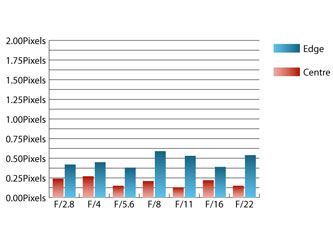 |
Falloff off illumination towards the corners can be quite pronounced at maximum aperture. At 70mm the corners are 1.92 stops darker than the image centre and visually uniform illumination is achieved at f/5.6, whereas at 200mm the corners are 2.6 stops darker than the centre and visually uniform illumination isn't achieved until f/8.
Distortion is minimal at 70mm with Imatast detecting 1.96% barrelling. At 200mm 1.12% pincushion distortion is present, which is a moderate level, but may be noticeable under certain circumstances. At both ends of the zoom the distortion pattern is uniform across the image area, which should make it simple to correct in image editing software afterwards.
During use this lens showed few signs of flare or loss of contrast, even when shooting into the light. The supplied petal shaped hood does an excellent job of keeping extraneous light out of the lens, further improving this lens' ability to cope under harsh conditions.
 |  | |
| Maximum magnification – ISO200, 1/125, f/11, 200mm | Bokeh – ISO100, 1/400, f/4, 200mm | |
 |  | |
| Wideangle – ISO100, 1/80, f/16, 70mm | Telephoto – ISO100, 1/60, f/16, 200mm |
 | DxOMark provides objective, independent, RAW-based image quality performance data for lenses and digital cameras to help you select the best equipment to meet your photographic needs. Visit the DxOMark website for tests performed on the Canon EF 70-200mm f/2.8L IS II USM. |
Add your message
Login required
Please login here or if you've not registered, you can register here. Registering is safe, quick and free.
Please login here or if you've not registered, you can register here. Registering is safe, quick and free.
photodo Stats
1102 lenses
428 MTF tests
74 in-depth photodo reviews
100+ users join each day
Help the lens community by reviewing or rating a lens today via our lens search
428 MTF tests
74 in-depth photodo reviews
100+ users join each day
Help the lens community by reviewing or rating a lens today via our lens search
Latest Lens Reviews
- Chinon 28mm f/2.8 Vintage Lens Review
- Canon EF 70-200mm f/4L IS II USM Lens Review
- Samyang AF 85mm f/1.4 EF Review
- Sigma 70mm f/2.8 DG Macro Art Review
- Samyang AF 24mm f/2.8 FE Review
- Meike 50mm f/1.7 Review
- Tamron 70-210mm f/4 Di VC USD Review
- Lensbaby Burnside 35mm f/2.8 Review
- Asahi Super Takumar 50mm f/1.4 Review
- Asahi Super-Multi-Coated Takumar 135mm f/3.5 Review
